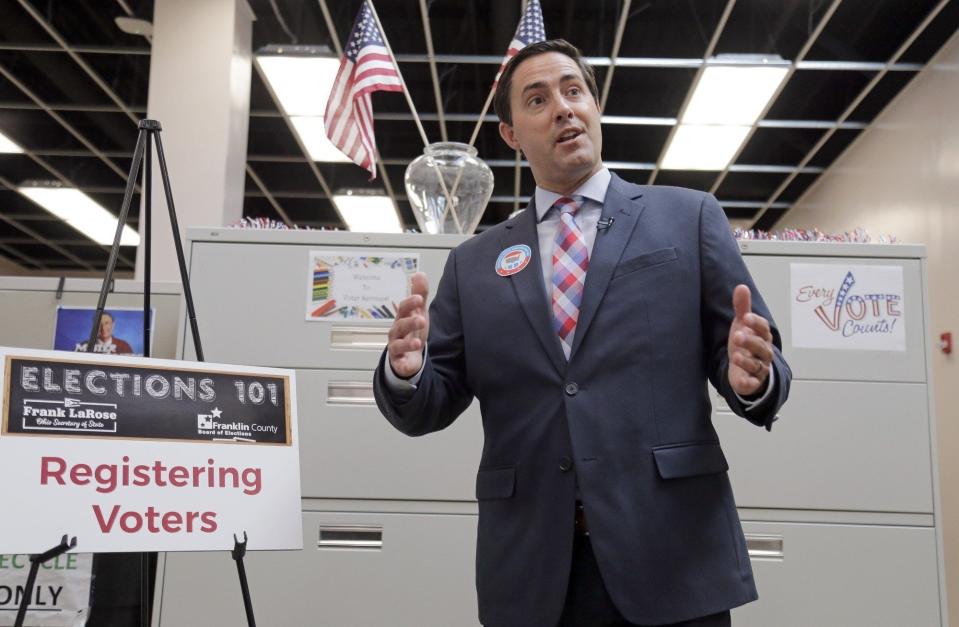If you think this election season is bad, stock up on Maalox for coming heartburn |Suddes

- Oops!Something went wrong.Please try again later.
- Oops!Something went wrong.Please try again later.
- Oops!Something went wrong.Please try again later.
- Oops!Something went wrong.Please try again later.
Thomas Suddes is a former legislative reporter with The Plain Dealer in Cleveland and writes from Ohio University. tsuddes@gmail.com
If you think Campaign '22 has stoked world-class heartburn, keep the Maalox handy: Campaign '24 will begin Nov. 9, the day after this year’s Election Day.
Not only will 2024 be a presidential election year – and if Donald Trump’s breathing, he’s running – but Ohioans will also be treated to another U.S. Senate race and to General Assembly and congressional contests in what will likely (yet again) be redrawn districts.
More:Ohio voters wanted redistricting reform. They got unconstitutional maps
Also between now and '24, potential successors to Republican Gov. Mike DeWine will emerge, assuming DeWine, age 75, is re-elected this November. If he is, DeWine couldn’t seek re-election in 2026 because of Ohio term limits for statewide executive officers.
DeWine’s heir apparent is Lt. Gov. Jon Husted, a fellow Republican, but Husted has recently shown interest in a private-sector billet. Last spring, Husted was elected to the board of directors of Heartland BancCorp in suburban Columbus, which owns Heartland Bank, a commercial bank that operates in Central Ohio and northern Kentucky.
If Husted doesn’t seek to succeed DeWine, then one of the other statewide Republican elected executive officers – say, Attorney General David Yost, Auditor of State Keith Faber – is a possible gubernatorial candidate. (If they’re re-elected in November, term limits will keep Faber and Yost from seeking third terms in 2026.)

More:How to submit guest opinion columns to the Columbus Dispatch
But in 2024, the big-ticket contest, after the presidency, will be for the U.S. Senate seat held by Cleveland Democrat Sherrod Brown, now in his third term.
Republican scuttlebutt is that Republican Secretary of State Frank LaRose, of suburban Columbus, is among those gearing up to challenge Brown, who won the Senate seat in the first place by unseating DeWine in 2006.
LaRose was one of the Ohio Republicans who appeared in Youngstown on Sept. 17, at a GOP rally featuring Trump. (So, in a rather nervy move, did this year’s three Republican candidates for the supposedly-above-politics Ohio Supreme Court, run 4-3 by the GOP.)
Were Brown elected to a fourth Senate term, he’d be only the second Ohio senator – since popular election of U.S. senators began in 1914 – to have done so; the other was the late Sen. John Glenn. (Ohio’s longest serving U.S. senator was Mansfield’s John Sherman, elected by the General Assembly, not voters; in the 1800s, Sherman served for 32 years in the upper house.)

Meanwhile, even as Campaign '24 emerges on Nov. 9, so too will politicking get into high gear at the Statehouse – not even counting the GOP fight over the House speakership. Leading candidates: Rep. Phil Plummer, of Dayton, once Montgomery County’s sheriff, and Rep. Jason Stephens, of Gallia County’s Kitts Hill.
The General Assembly is expected to reconvene after the election to hold one of its always rambunctious “lame-duck” sessions.
That is, some House and Senate members who likely will never again face voters may act on legislation way too hot to handle before the election.
Traditionally, lame-duck sessions, such as 2018’s, are when legislators give themselves pay raises. That’s unlikely during this year’s lame-duck session because the 2018 pay raise bill (passed over Republican then-Gov. John R. Kasich’s veto) annually boosts legislative pay every year through 2028.
This year, base pay for a member of the General Assembly is $68,674 for what is legally a part-time job. The Census reports that median household income in Ohio is $58,116 – which is 15% less than a General Assembly member’s base salary. And most legislators are paid more than the base amount.
Bottom line, anti-abortion, anti-transgender, and anti-critical-race theory measures may surface on the General Assembly’s to-do list, led off by anti-abortion bills. It’s inspirational to watch the General Assembly of a state with so many other pressing problems find the time to keep Ohio safely in the Stone Age on race, sex, and pregnancy.
The upside for the Statehouse banking, insurance and utility lobbies is that the fireworks those social issues ignite will distract voters from noticing sweetheart bills to boost the bottom lines of assorted special interests. No, to borrow the state’s one-time development slogan, profit certainly isn’t a dirty word in Ohio. But progress is.
Thomas Suddes is a former legislative reporter with The Plain Dealer in Cleveland and writes from Ohio University. tsuddes@gmail.com
Get more political analysis by listening to the Ohio Politics Explained podcast
This article originally appeared on The Columbus Dispatch: Thomas Suddes: Who will run for election in 2024?

